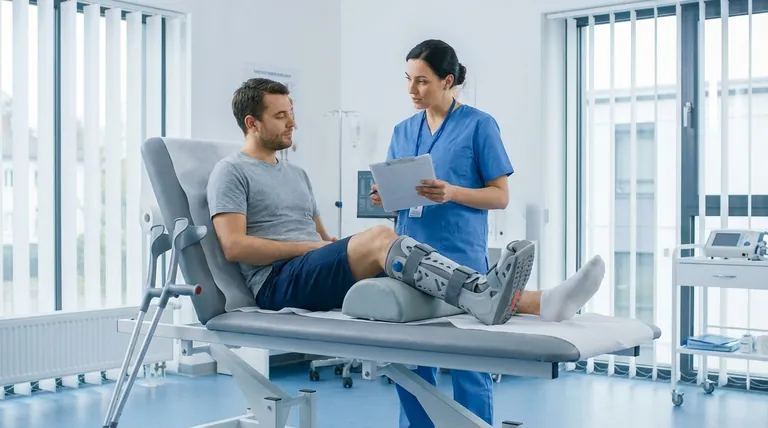The absolute priority during the non-weight bearing phase with a walking boot is to allow the injured area to heal completely, free from the stress of supporting your body's weight. This period of significantly reduced activity is not passive; it is a critical and active stage of recovery designed to create an undisturbed environment for your body to repair itself.
The non-weight bearing phase isn't about general inactivity; it's about protected healing. Your sole focus must be on preventing any pressure on the injured limb, as directed by your provider, to ensure the structural repair is sound before progressing to the next stage.

The Logic Behind the Recovery Phases
A structured recovery process ensures that stress is only applied to the injured area when it is capable of handling it. This progression is methodical and essential for preventing re-injury.
Phase 1: Non-Weight Bearing (The Healing Foundation)
This is the most fragile stage of recovery. The walking boot's primary function here is immobilization and protection, not to facilitate walking.
Its purpose is to shield the bone or soft tissue from accidental bumps and to hold the joint in a neutral position, optimizing the healing conditions.
Depending on the specific injury or surgical procedure, this phase may not be necessary for every patient.
Phase 2: Weight Bearing in the Boot (The Gradual Re-introduction)
Once your provider determines sufficient healing has occurred, you will transition to bearing weight. This is a crucial step in re-introducing load to the limb.
The boot continues to provide support and stability, but now it helps distribute pressure as you begin to walk. This phase gradually rebuilds the capacity of the injured area.
Phase 3: Full Weight Bearing Without the Boot (Restoring Function)
This final phase marks the transition back to normal activity. The focus shifts entirely to rehabilitation.
Key goals include rebuilding lost muscle strength, restoring a full range of motion and flexibility, and re-learning normal balance and walking patterns.
Common Pitfalls to Avoid
Adherence to the non-weight bearing protocol is the single most important factor for success. Deviating from the plan, even slightly, can have significant consequences.
The Danger of "Testing" the Injury
It is common to feel tempted to put a small amount of weight on the foot to "see how it feels." This is a critical mistake.
Even minor pressure can disrupt the delicate healing process occurring at the cellular level, potentially causing a setback that prolongs your recovery.
Ignoring Your Provider's Timeline
The decision to begin bearing weight is a medical one, often confirmed by imaging like an X-ray. It is not based on how you feel.
Advancing to the next phase before receiving clearance from your attending provider is the most common cause of complications and re-injury.
Making the Right Choice for Your Recovery
Your actions during this initial phase directly influence the speed and success of the entire process. Use this time strategically to set yourself up for the best possible outcome.
- If your primary focus is the fastest possible recovery: Strictly adhere to the zero-weight-bearing instructions without exception, as any deviation is a direct risk to your healing timeline.
- If your primary focus is maintaining overall health: Consult your provider or a physical therapist about safe, non-weight bearing exercises for your upper body and uninjured leg to maintain circulation and strength.
- If your primary focus is a smooth transition to the next phase: Use this time to understand the complete recovery plan and ask your provider what to expect when you begin bearing weight.
Your discipline during this foundational non-weight bearing phase directly dictates the quality and speed of your entire recovery journey.
Summary Table:
| Recovery Phase | Primary Goal | Key Focus |
|---|---|---|
| Phase 1: Non-Weight Bearing | Protected Healing | Immobilization; Zero pressure on the injured limb. |
| Phase 2: Weight Bearing in Boot | Gradual Re-introduction | Re-introducing load with boot support and stability. |
| Phase 3: Full Weight Bearing | Restoring Function | Rehabilitation, strength, and mobility without the boot. |
Ready for a Smooth Recovery? Let 3515 Support Your Journey.
As a large-scale manufacturer, 3515 produces a comprehensive range of high-quality, supportive footwear for distributors, brand owners, and bulk clients. Our production capabilities encompass all types of therapeutic and recovery shoes and boots, designed to provide the immobilization and protection essential for each phase of healing.
Let us help you or your patients navigate recovery with confidence. Our footwear solutions are engineered for durability, comfort, and optimal support.
Contact 3515 today to discuss your specific needs and discover how our products can contribute to successful recovery outcomes.
Visual Guide

Related Products
- Safety Footwear Wholesale Manufacturer for Custom OEM/ODM Production
- Premium Grain Leather Safety Boots for Bulk Supply
- Wholesale Safety Footwear Manufacturer for Bulk & Custom OEM Orders
- Premium Wholesale Wheat Nubuck Safety Boot with Rapid Lacing System
- Customizable Anti-Smash Safety Boots for Wholesale & Private Label Manufacturing
People Also Ask
- What do heavy duty boots do? Protect Your Feet in Demanding Work Environments
- Is safety-toe as good as steel toe? Choose the Right Protection for Your Job
- What are the cultural perspectives on wearing shoes in the house? A Guide to Home Etiquette & Hygiene
- Do snake bite boots work? Your Ultimate Guide to Effective Snake Bite Protection
- How long can you wear safety boots? The Lifespan is Determined by Wear, Not Time



















